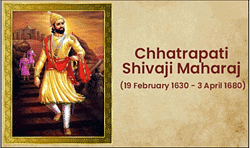History, Art & Culture: March 2022 Current Affairs - UPSC PDF Download
Lachit Borphukan
Why in News?
Indian President will inaugurate a year-longcelebration of the 400th birth anniversary of Lachit Borphukan.
- Earlier, the Prime Minister called 17th century Ahom general Lachit Borphukan a symbol of India’s “Atmanirbhar military might”.
Who was Lachit Borphukan?
- Born on 24th November, 1622, Borphukan was known for his leadership in the Battle of Saraighat, 1671 in which an attempt by Mughal forces to capture Assam was thwarted.
- He was the inspiration behind strengthening India’s naval force and revitalising inland water transport and creating infrastructure associated with it due to his great naval strategies.
- The Lachit Borphukan gold medal is awarded to the best cadet from the National Defence Academy. The medal was instituted in 1999 to inspire defence personnel to emulate Borphukan’s heroism and sacrifices.
- He died on 25th April, 1672.
What was the Battle of Saraighat?
- The battle of Saraighat was fought on the banks of the Brahmaputra in Guwahati in 1671.
- It is considered as one of the greatest naval battles on a river which resulted in the victory of Ahoms over the Mughals.
What was Ahom Kingdom?
1. Founder
Chaolung Sukapha was a 13th century ruler who founded the Ahom kingdom that ruled Assam for six centuries. The Ahoms ruled the land till the province was annexed to British India in 1826 with the signing of the Treaty of Yandaboo.
2. Political Setup
Ahoms created a new state by suppressing the older political system of the bhuiyans (landlords). The Ahom state depended upon forced labour. Those forced to work for the state were called paiks.
3. Society
Ahom society was divided into clans or khels. A khel often controlled several villages. Ahoms worshipped their own tribal gods, yet they accepted the Hindu religion and the Assamese language.
- However, the Ahom kings did not completely give up their traditional beliefs after adopting Hinduism. Intermarriage with local also increased assimilation processes of Ahoms in Assamese culture.
4. Art and Culture
Poets and scholars were given land grants and theatre was encouraged. Important works of Sanskrit were translated into the local language. Historical works, known as buranjis, were also written, first in the Ahom language and then in Assamese.
5. Military Strategy
The Ahom king was the supreme commander of the state as well as the Military. The Ahom king himself led the state forces in the time of wars. The Paiks were the main army of the state.
- There were two types of Paiks i.e. serving and non-serving. The non-serving Paiks constituted a standing militia which could be mobilized at a short notice by the kheldar (an expert military organizer).
The full contingent of the Ahom Army consisted of infantry, navy, artillery, elephantry, cavalry and spies. The main war weapons consisted of bows and arrows, swords, Javelins discus, guns, matchlocks and cannons.
The Ahoms sent spies to the enemy’s camp to study the strength and the war strategies of the enemies before leading an expedition. The Ahom soldiers were experts in guerilla fighting. Sometimes they allowed the enemies to enter the country, then cut off their communications and attack them in front and rear. - Few important forts: Chamdhara, Saraighat, Simlagarh, Kaliabar, Kajali and Pandu. They also learnt the technique of constructing boatbridges in the Brahmaputra.
- Above all, the mutual understanding among the civil and military wings, unity among the nobles always worked as strong weapons of the Ahoms
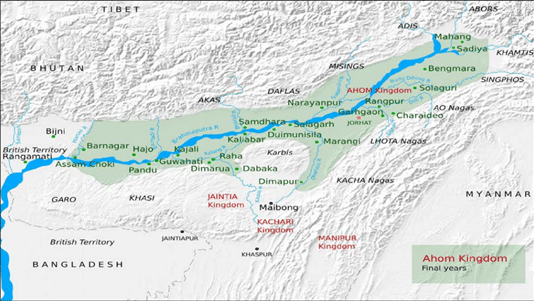
Shivaji Jayanti 2022
Why in News?
Chhatrapati Shivaji Maharaj Jayanti is celebrated each year on 19th February to remember and praise his courage, warfare tactics and administrative skills.
- He carved an enclave from the declining Adilshahi sultanate of Bijapur that formed the genesis of the Maratha Kingdom.
- In 1870, social reformer Mahatma Jyotirao Phule initiated the celebration Shiv Jayanti in Pune which is now known as Chhatrapati Shivaji Maharaj Jayanti.
What are the Key Points Related to Chhatrapati Shivaji Maharaj ?
1. Birth
He was born on 19th February, 1630 at Shivneri Fort in District Pune in the present-day state of Maharashtra. He was born to Shahaji Bhonsle, a Maratha general who held the jagirs of Pune and Supe under the Bijapur Sultanate and Jijabai, a pious woman whose religious qualities had a profound influence on him.
2. Early Life
He displayed his military zeal for the first time in 1645 when as a teenager, he successfully got control of the Torna Fort which was under Bijapur. He also acquired the Kondana Fort. Both these forts were under Adil Shah of Bijapur.
3. Important Battles:
(i) Battle of Pratapgad, 1659
- Fought at the fort of Pratapgad near the town of Satara, Maharashtra, between the forces of the Maratha king Chhatrapati Shivaji Maharaj and the Adilshahi general Afzal Khan.
(ii) Battle of Pavan Khind, 1660
- Fought at a mountain pass in the vicinity of fort Vishalgad, near the city of Kolhapur, Maharashtra, between the Maratha Sardar Baji Prabhu Deshpande and Siddi Masud of Adilshahi.
(iii) Sacking of Surat, 1664
- Fought near the city of Surat, Gujarat, between Chhatrapati Shivaji Maharaj and Inayat Khan, a Mughal captain.
(iv) Battle of Purandar, 1665
- Fought between the Mughal Empire and Maratha Empire.
(v) Battle of Sinhagad, 1670
- Fought on the fort of Sinhagad near the city of Pune, Maharashtra between Tanaji Malusare, a commander of Maratha ruler Shivaji Maharaj and Udaybhan Rathod, fortkeeper under Jai Singh I who was a Mughal Army Chief.
(vi) Battle of Kalyan, 1682-83
- Bahadur Khan of the Mughal Empire defeated the Maratha army and took over Kalyan.
(vii) Battle of Sangamner, 1679
- Fought between the Mughal Empire and Maratha Empire. This was the last battle in which the Maratha King Shivaji fought.
- Conflict with Mughals: He raided Mughal territory near Ahmednagar and in Junnar, 1657. Aurangzeb responded to the raids by sending Nasiri Khan, who defeated the forces of Shivaji at Ahmednagar. Shivaji defeated a large force of Shaista Khan (Aurangzeb’s maternal uncle) and the Bijapur army in Pune,1659.
In 1664, the wealthy Mughal trading port of Surat was sacked by Shivaji. In June 1665, the Treaty of Purandar was signed between Shivaji and Raja Jai Singh I (representing Aurangzeb). - As per this treaty, many forts were relinquished to the Mughals and it was agreed that Shivaji would meet Aurangzeb at Agra. Shivaji also agreed to send his son Sambhaji as well.
Arrest of Shivaji
When Shivaji went to meet the Mughal emperor at Agra in 1666, the Maratha warrior felt he was insulted by Aurangzeb and stormed out of the court. He was arrested and kept prisoner. The clever escape of Shivaji and his son from imprisonment in disguise out of Agra is legendary today.
After that there was peace between the Marathas and the Mughals until 1670.
The jagir of Berar which was granted to Sambhaji by the Mughals was taken back from him. Shivaji in response attacked and recovered many territories from the Mughals in a short span of four months.
Through his military tactics, Shivaji acquired a large part of the land in the Deccan and western India.
1. Granted Title
He took on the titles of Chhatrapati, Shakakarta, Kshatriya Kulavantas and Haindava Dharma Dharak. The Maratha Kingdom founded by Shivaji grew larger over time and became the dominant Indian power in the early 18th century.
2. Death
- Shivaji passed away in Raigad in 1680 and was cremated at the Raigad Fort.
How was the Administration under Shivaji ?
1. Central Administration
It was founded by Shivaji for the sound system of administration which was greatly inspired from the Deccan style of administration.
Most of the administrative reforms were inspired from Malik Amber reforms in Ahmednagar.
The King was the supreme head of state who was assisted by a group of eight ministers known as the ‘Ashtapradhan’.
The peshwa, also known as the mukhya pradhan, originally headed the advisory council of the raja Shivaji.
2. Revenue Administration
Shivaji abolished the Jagirdari System and replaced it with Ryotwari System, and changes in the position of hereditary revenue officials which was popularly known as Deshmukhs, Deshpande, Patils and Kulkarnis. Shivaji strictly supervised the Mirasdars who had hereditary rights in land.
The revenue system was patterned on the Kathi system of Malik Amber in which every piece of land was measured by Rod or Kathi. Chauth and Sardeshmukhi were other sources of income.
- Chauth amounted to 1/4th of the standard which was paid to Marathas as a safeguard against Shivaji’s forces raiding Non-Maratha territories.
- Sardeshmukhi was an additional levy of 10% demanded from areas outside of the kingdom.
3. Military Administration
Shivaji organized a disciplined and efficient army. The ordinary soldiers were paid in cash, but the chief and military commander were paid through jagir grants (Saranjam or Mokasa). The army consists of Infantry i.e. Mavali foot soldiers, Cavalry i.e. Horse riders and equipment holders, Navy.
Veer Savarkar
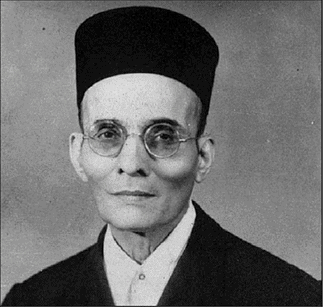
Why in News?
Recently, the Prime Minister has paid tributes to freedom fighter Veer Savarkar on his Punya tithi (26th February).
Who was Veer Savarkar?
1. Birth
Born on 28th May,1883 in Bhagur, a village near Nashik in Maharashtra.
2. Related Organisations and Work
Founded a secret society called Abhinav Bharat Society. Went to the United Kingdom and was involved with organizations such as India House and the Free India Society. He was the president of Hindu Mahasabha from 1937 to 1943. Savarkar wrote a book titled ‘The History of the
War of Indian Independence’ in which he wrote about the guerilla warfare tricks used in 1857 Sepoy Mutiny. He also wrote the book ‘Hindutva: who is hindu?’.
3. Trial and Sentences
Arrested in 1909 on charges of plotting an armed revolt against the Morley-Minto reform (Indian Councils Act 1909). Arrested in 1910 for his connections with the revolutionary group India House. One of the charges on Savarkar was abetment to murder of Nashik Collector Jackson and the second was waging a conspiracy under Indian Penal Code 121-A against the King emperor. Following the two trials, Savarkar was convicted and sentenced to 50-years imprisonment also known as Kala Pani and transported in 1911 to the Cellular Jail in the Andaman and Nicobar Islands.
4. Death
He died on 26th February 1966 due to fasting on his own wish of death.
Maharishi Dayanand Saraswati Jayanti
Why in News?
Maharishi Dayanand Saraswati Jayanti is celebrated every year to mark the birth anniversary of the Maharishi Dayanand Saraswati.
- This year, the day will be celebrated on 26th February.
- As per the traditional Hindu calendar, Dayanand Saraswati was born on the Dashami Tithi of Phalguna Krishna Paksha.
Who was Maharishi Dayanand Saraswati?
1. Birth
Swami Dayanand Saraswati was born on 12th February 1824 in Tankara, Gujarat in a Brahmin family. His parents, Lalji Tiwari and Yashodhabai were orthodox Brahmin. He was earlier named Mool Shankar Tiwari as he was born during Mool Nakshatra. He wandered as an ascetic for fifteen years (1845 - 60) in search of truth.
Dayananda’s views were published in his famous work, Satyarth Prakash (The True Exposition).
2. Contribution to the Society
He was an Indian philosopher, social leader and founder of the Arya Samaj.
- Arya Samaj is a reform movement of Vedic dharma and he was the first to give the call for Swaraj as “India for Indian” in 1876. He was a self-taught man and a great leader of India leaving a significant impact on Indian society. During his life, he made a prominent name for himself and was known among a wide array of Prices and the public. The first Arya Samaj unit was formally set up by him at Mumbai (then Bombay) in 1875 and later the headquarters of the Samaj were established at Lahore.
- His vision of India included a classless and casteless society, a united India (religiously, socially and nationally), and an India free from foreign rule, with Aryan religion being the common religion of all. He took inspiration from the Vedas and considered them to be ‘India’s Rock of Ages’, the infallible and the true original seed of Hinduism. He gave the slogan “Back to the Vedas”.
- He subscribed to the Vedic notion of chaturvarna system in which a person was not born in any caste but was identified as a brahmin, kshatriya, vaishya or shudra according to the occupation the person followed.
3. Contribution to the Education System
He introduced a complete overhaul of the education system and is often considered as one of the visionaries of modern India. The DAV (Dayanand Anglo Vedic) schools came into existence in 1886 to realize the vision of Swami Dayanand Saraswati. The first DAV School was established at Lahore with Mahatma Hansarj as the headmaster.
What is Arya Samaj?
- It aims to reestablish the Vedas, the earliest Hindu scriptures, as revealed truth. He rejected all later accretions to the Vedas as degenerate but, in his own interpretation, included much post-Vedic thought. During the 1920s and early 1930s tension grew around a number of issues. Muslims were angered by “music-before-mosque”, by the cow protection movement, and by the efforts of the Arya Samaj to bring back to the Hindu fold (shuddhi) those who had recently converted to Islam.
- The Arya Samaj has always had its largest following in western and northern India.
- The Samaj opposes worship of murtis (images), animal sacrifice, shraddha (rituals on behalf of ancestors), basing caste upon birth rather than upon merit, untouchability, child marriage, pilgrimages, priestly craft, and temple offerings.
- It upholds the infallibility of the Vedas, the doctrines of karma (the accumulated effect of past deeds) and samsara (the process of death and rebirth), the sanctity of the cow, the importance of the samskaras (individual sacraments), the efficacy of Vedic oblations to the fire, and programs of social reform.
- It has worked to further female education and intercaste marriage; has built missions, orphanages, and homes for widows; has established a network of schools and colleges; and has undertaken famine relief and medical work.
Statehood Day of Arunachal Pradesh
Why in News?
Recently, the Prime Minister of India extended his wishes to the people of Arunachal Pradesh on its 36th Statehood Day.
- Through the 55th amendment to the Indian Constitution in 1986, Arunachal Pradesh became the 24th state of the Indian Union on 20th February, 1987.
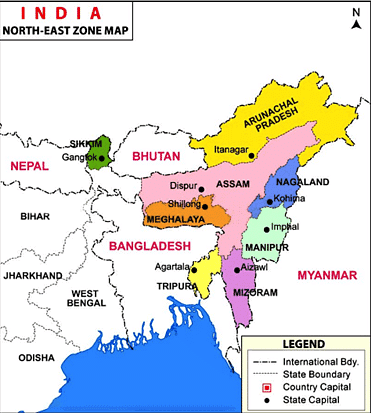
What do we Know about Arunachal Pradesh?
- Historical Background: During the British Colonial Rule, until 1972, the state was named as the NorthEast Frontier Agency (NEFA). On 20th January, 1972, it became a Union Territory and was named Arunachal Pradesh. It was granted statehood by the State of Arunachal Pradesh Act, 1986.
- Geographical location: The state was formed out of Assam in the year 1987. In the west, Arunachal Pradesh is bordered by Bhutan and in the north falls the Tibetan region of China. In the Southeastern region falls Nagaland and Myanmar and to the southwestern region falls Assam.
- Demography: The capital of Arunachal Pradesh is Itanagar. The total literacy rate of the state (as per Census 2011) is 65.38% with male literacy rate being 72.55% and for females, it is 57.70%. The Sex Ratio of the states is 938 female per 1000 male (National: 943). The state is home to 26 major tribes, there are more than 100 sub-tribes, many of them are still unexplored. About 65% of the population of the state is tribals.
- Occupation: Mostly the population of the state depends on Agriculture, mainly Jhum cultivation (slash and burn cultivation). Other cultivation of cash crops is also done like potatoes. Horticulture crops such as pineapple, apple, oranges, etc are also done.
- Biodiversity
(i) State Animal: Mithun (also known as Gayal)
(ii) State Bird: Hornbill
It is also home to the Dihang Dibang Biosphere Reserve. - Protected Areas
(i) Namdapha National Park
(ii) Mouling National Park
(iii) Sessa Orchid Sanctuary
(iv) Dibang Wildlife Sanctuary
(v) Pakke Tiger Reserve - Tribals of Arunachal: The significant tribal groups include Monpas, Nyishis, Apatanis, Noctes and Sherdukpens.
- Monpas: They are believed to be the only nomadic tribe of northeast, inhabit the West Kameng and Tawang districts, are essentially Buddhists who follow the Mahayana sect.
- Apatanis: They practice pre-Aryan beliefs, which is evident from their worship of trees, rocks and plants amongst other things. They mainly practise bamboo cultivation.
- Noctes: Found in the Tirap district, they follow Theravada Buddhism and Animism.
- Sherdukpens: A small tribal group, they are one of the most progressive tribes that can be found in Arunachal Pradesh practising agriculture, fishing and rearing of livestock. Although they have adopted Buddhism, most of their practices still remain pre-Buddhist and more Animistic.
- Nyishis: They are the most populous tribe of Arunachal Pradesh and are mainly involved in shifting cultivation and produce rice, millet, cucumber, etc.
Statehood Day of Mizoram
Why in News?
Recently, the Prime Minister of India extended his wishes to the people of Mizoram on its 36th Statehood Day (20th February).
- The formalization of Mizoram State took place on 20th February, 1987 after the 53rd Amendment of the Indian Constitution, 1986.
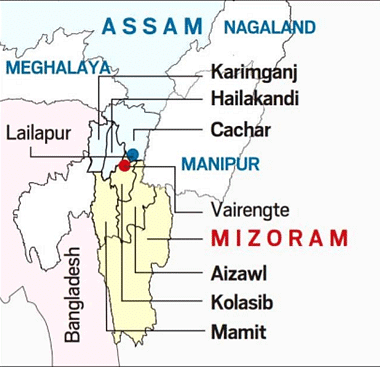
What do we know about Mizoram?
- Historical background: The Mizo hills area became the Lushai Hills district within Assam at the time of independence. Further, in 1954 it was renamed the Mizo Hills District of Assam. Mizoram was granted the status of a Union Territory in 1972 after signing an accord with the moderates of the Mizo National Front (MNF). The Union Territory of Mizoram was conferred the status of a full state in 1986 after signing of a memorandum of settlement (Mizoram Peace Accord) between the Central government and the MNF
- Geographical Location
(i) International Border: Myanmar and Bangladesh
(ii) State Border: Tripura (northwest), Assam (north) and Manipur (northeast). - Demography: Mizoram population in 2022 is estimated to be 1.27 Million and is the second least populous state in India after Sikkim.
- The Sex Ratio is 975 female per 1000 male (National: 943). The Literacy rate of the state is 91.58 % (National: 74.04%).
- Biodiversity: According to India State of Forest Report (ISFR), 2021 Mizoram has the maximum forest cover as a percentage of their own geographical area at (84.53%) from the North eastern region of the country.
(i) State Animal: Saza (serow)
(ii) State Bird: Vavu (Hume Bartailed Pheasant). - Protected Areas:
(i) Dampa Tiger Reserve
(ii) Murlen National Park
(iii) Phawngpui National Park
(iv) Ngengpui Wildlife Sanctuary
(v) Tawi Wildlife Sanctuary - Tribals: It has the highest concentration (percentage) of tribal population among the north-eastern states of India. Mizos consisting of 5 major and 11 minor tribes known as Awzia. The 5 major tribes include: Lushei, Ralte, Hmar, Paihte and Pawi. The Mizos are a close- knit society with no class distinction and discrimination on grounds of sex, status or religion.
Mizos are agriculturists, practise “Jhum Cultivation” or slash- and- burn system of cultivation. - Festivals and Dance: The Mizos have two main festivals- Mim Kut and Chapchar Kut.
(i) Mim Kut: It is a Maize festival that is celebrated during the months of August and September, after the harvest of maize.
(ii) Chapchar Kut: It is a Spring Festival, most popular and celebrated after completion of the task of jungle clearing for “jhum” operations.
The most colourful and distinctive dance of the Mizo is called Cheraw. Long bamboo staves are used for this dance, therefore many people call it ‘Bamboo Dance’.
Goa’s Liberation Struggle
Why in News
Recently, the liberation of Goa became a controversial topic during the political campaign in the election of Goa.
- In 1962, Goa was liberated from Portuguese rule, 15 years after India attained freedom in 1947. Goa, not becoming independent immediately after independence was because of a variety of complex factors.
- Goa was liberated on 19th December 1961 (Statehood Day of Goa) by swift Indian military action that lasted less than two days.
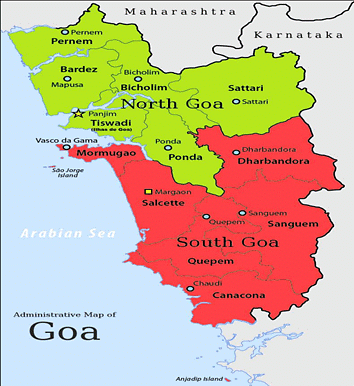
What is the Timeline of Integration of Goa into the Indian Union?
- Relations between India and Portugal began amicably in 1947 after India’s independence and diplomatic relations were established in 1949.
- Bilateral relations however went into decline after 1950 over Portugal’s refusal to surrender its enclaves of Goa, Daman and Diu and Dadra and Nagar Haveli on India’s west coast. Daman & Diu and Dadra and Nagar Haveli were integrated into India in 1961.
- Portugal had changed its constitution in 1951 to claim Goa not as a colonial possession, but as an overseas province.
- The move was apparently aimed at making Goa a part of the newly formed North Atlantic Treaty Organisation (NATO) military alliance. It was intended to invoke the collective security clause of the treaty, in the event of an attack by India.
- By 1955, the two nations had cut off diplomatic relations, triggering a crisis which precipitated the liberation of Goa by Indian military forces, ending Portuguese rule over Indian enclaves in 1961.
- In 1961, after the failure of diplomatic efforts with the Portuguese, the Indian Government launched Operation Vijay and annexed Daman and Diu and Goa with the Indian mainland on 19th December.
- It brought an end to 451 years of Portuguese overseas provincial governance in Goa.
What is the History of Goa’s Freedom Movement?
- Goa became a Portuguese colony in 1510, when Admiral Afonso de Albuquerque defeated the forces of the sultan of Bjiapur, Yusuf Adil Shah.
- By the turn of the twentieth century, Goa had started to witness an upsurge of nationalist sentiment opposed to Portugal’s colonial rule, in sync with the anti-British nationalist movement in the rest of India.
- Stalwarts such Tristão de Bragança Cunha, celebrated as the father of Goan nationalism, founded the Goa National Congress at the Calcutta session of the Indian National Congress in 1928.
- In 1946, the socialist leader Ram Manohar Lohia led a historic rally in Goa that gave a call for civil liberties and freedom, and eventual integration with India, which became a watershed moment in Goa’s freedom struggle.
- At the same time, there was a thinking that civil liberties could not be won by peaceful methods, and a more aggressive armed struggle was needed. This was the view of the Azad Gomantak Dal (AGD).
- As India moved towards independence, however, it became clear that Goa would not be free any time soon, because of a variety of complex factors like:
(i) Trauma of Partition
(ii) Experience of War with Pakistan
(iii) India wanted to showcase itself as a peace-abiding nation.
Portugal being member of NATO
- These factors kept the Government of India from opening another front in which the international community could get involved.
- Besides, it was Mahatma Gandhi’s opinion that a lot of groundwork was still needed in Goa to raise the consciousness of the people, and the diverse political voices emerging within should be brought under a common umbrella first.
- The dichotomies within the groups fighting (Satyagraha vs Military Action) for freedom in Goa, also led to delay in liberation of Goa. The idea of satyagraha emphasised the power of truth and the need to search for truth. It suggested that if the cause was true, if the struggle was against injustice, then physical force was not necessary to fight the oppressor.
What are the Salient Features of Goa’s Geography?
1. About
Goa is located on the southwestern coast of India within the region known as the Konkan, and geographically separated from the Deccan highlands by the Western Ghats.
2. Capital: Panji.
3. Official Language: Konkani which is one of the 22 languages from the Eight Schedule.
4. Borders: It is surrounded by Maharashtra to the north and Karnataka to the east and south, with the Arabian Sea forming its western coast.
5. Geography: The highest point of Goa is Sonsogor. Goa’s seven major rivers are the Zuari, Mandovi, Terekhol, Chapora, Galgibag, Kumbarjua canal, Talpona and the Sal. Most of Goa’s soil cover is made up of laterites.
6. Wildlife Sanctuaries and National Parks:
(i) Dr. Salim Ali Bird Sanctuary
(ii) Mhadei Wildlife Sanctuary
(iii) Netravali Wildlife Sanctuary
(iv) Cotigao Wildlife Sanctuary
(v) Bhagwan Mahaveer Sanctuary
(vi) Mollem National Park
Konark Sun Temple
- Odisha government has planned to run the Konark Sun Temple completely on solar energy. Konark is going to be the 1st model town in Odisha to shift from grid dependency to green energy.
- By 2022-end, the state has targeted to generate 2,750 megawatt (MW) from renewable energy sources like the sun, wind, biomass, small hydro and waste-to energy (WTE), etc. Konark Sun Temple
- It is a 13th-century CE temple dedicated to sun god Surya, at Konark on the coastline of Odisha. It was built by King Narasimhadeva I of Eastern Ganga Dynasty around 1250 CE.
- The word 'Konark' is a combination of two Sanskrit words kona (corner or angle) and arka (the sun). The temple is conceived as a giant stone chariot with 24 wheels and 7 horses.
- Once over 200 feet (61 m) high, much of the temple is now in ruins. The structures and elements that have survived are popular for their intricate artwork, iconography, and themes.
- The temple follows the Kalinga or Orissa style of architecture, which is a subset of nagara style of Hindu temple architecture.
- Declared a UNESCO world heritage site in 1984, it is a major pilgrimage site for Hindus, who gather here every year for the Chandrabhaga Mela around the month of February.
- This temple was called the Black Pagoda in European sailor accounts as early as 1676 because its great tower appeared black.
- Similarly, the Jagannath Temple in Puri was called the White Pagoda. Both temples served as important landmarks for sailors in the Bay of Bengal.
Theyyam
- As part of its efforts to promote cultural tourism, Kerala Tourism has decided to live stream Theyyam performances. Theyyam is a popular ritual form of dance worship in Kerala and Karnataka. It consists of thousand-year-old traditions, rituals and customs.
- The ceremonious dance is accompanied by the chorus of musical instruments like Chenda, Elathalam, Kurumkuzal and Veekkuchenda. Each Theyyam is a man or a woman who attained divine status by performing heroic deeds or by leading a virtuous life.
- Most Theyyams are believed to be the incarnations of Shiva or Shakti (the consort of Shiva) or they have strong associations with these principal deities of Hinduism.
- The people consider Theyyam itself as a channel to God and they thus seek blessings from Theyyam.
- There are over 400 separate Theyyams, each with their own music, style and choreography. The most prominent among these are Raktha Chamundi, Kari Chamundi, Muchilottu Bhagavathi, Wayanadu Kulaven, Gulikan and Pottan.
- Theyyam is performed by males, except the Devakoothu theyyam; the Devakoothu is the only Theyyam ritual performed by women.
Pandrethan Temple
- The Chinar Corps of the Indian Army was recently accorded recognition by the National Monuments Authority (NMA), for preserving and rejuvenating the Pandrethran temple.
- The Chinar Corps had adopted the ancient excavation site within the cantonment and after restoration, had named it ‘Dharohar’.
- The Pandrethan temple, an 8th century heritage site is situated in Srinagar’s Badamibagh.
- The site hosts several excavated figurines tracing back to the 2nd century – in the form of two large monolithic rock shiva lingams, seven Gandhara-style sculptures and a huge rock carving of the feet of a monolithic statue.
- Situated in the foothills of Zabarwan range, and on Jhelum River banks, it has magnificent sculptures of Shiva Trimurti, Varah and Padmapani Avalikiteshwara.
- The site near Shiva temple was excavated by the British-era ASI in 1913, yielding several Buddhist sculptures and rubbles of a Chaitya assignable to the 8th century.
- National Monuments Authority (NMA): NMA has been set up as per the provisions of The Ancient Monuments and Archaeological Sites and Remains (AMASR) Act, 2010. It operates under the aegis of the Ministry of Culture.
- Several functions have been assigned to the NMA for the protection and preservation of monuments and sites through management of the prohibited and regulated area around the centrally protected monuments.
GI Tag For Nagaswaram
- Nagaswaram made in Narasinghapettai in Thanjavur district has been granted the Geographical Indication (GI) tag under the category of musical instruments.
- The musical instrument is traditionally made by artisans based in a village near Kumbakonam who make them through specialized processing skills, a technique inherited from their forefathers.
- GI Tag is issued for agricultural, natural, or manufactured goods that have a unique quality, reputation, or other characteristics attributable to their geographical origin.
Nagaswaram
- Nagaswaram is a wind instrument that has also been accorded a high status as a ‘Mangala Vadyam’ and is played in religious ceremonies, auspicious occasions, and classical concerts.
- The instrument is also known as ‘nakaswaram’. It is believed that Lord Shiva gifted the instrument to the demon, Nagasuran. It has the shape of a snake, and nagas (meaning snakes) used this instrument, hence it came to be known as nagaswaram.
- The double-reeded instrument is made up of wood and has two parts – a conical tube and a metal bell. The major portion of the ‘Narasinghapettai nagaswaram’ is made from the Aacha (Hardwickia binata) tree.
- The horn-like portion of Nagaswaram is known as ‘Olavi’ and the loudspeaker-like portion ‘anasu’. ‘Jeevali’ is played at one end of the horn. It is through this ‘jeevali’ that air is blown.
Benefits of GI Tag
- Financial Assistance: The GI tag will help the artisans receive assistance from the Indian government. Further, it can also boost the trade of nagaswaram makers.
- Benefits to country: The tag increases the significance and the popularity of the product and enhances export opportunities. Furthermore, it also promotes government initiatives such as Vocal for Local, Buy Tribal, domestic and rural tourism, and more.
- Protects the culture: Artisans possess unique skills and knowledge of traditional practices and methods, passed down from generation to generation, which needs to be protected and promoted. With GI tags, the products get due acknowledgment, promotion, and protection.


